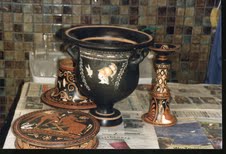Fabio Isman has now revealed that the Apulian pyxis shown at the front of the same photograph has been spotted in a New York gallery (Fabio Isman, "Tutto iniziò negli anni Settanta, quando il Met...", Il Giornale dell'Arte gennaio 2011). Isman comments:
Una pisside apula a figure rosse del 340 a.C., una scatola di forma tonda che apparteneva a una misteriosa «collezione inglese» ed è stata acquistata a Londra nel 1990, è apparentemente ritratta invece nel laboratorio di Fritz e Harri Bürki, padre e figlio di Zurigo (Fritz era bidello nell’università dove ha studiato Hecht), perquisiti dalla giustizia italiana che ha loro sequestrato anche altri oggetti: hanno restaurato tra l’altro il cratere di Eufronio con la Morte di Sarpedonte. La pisside apula, la cui foto era tra quelle di Medici, è immortalata proprio accanto a uno degli oggetti finiti al Museo di Madrid.The pxyis was attributed to the Baltimore painter by A.D. Trendall.
Isman's article is informed by the meticulous work of Cambridge researcher Christos Tsirogiannis. Some 16 objects were linked to the photographic archives obtained through raids in Geneva, Basel and on the island of Schinousa. Isman makes clear that how it had been possible to consult the images:
Il portfolio di Medici è stato pubblicato, e per qualche tempo era possibile consultarlo, sul sito del Comando Carabinieri per la Tutela del patrimonio culturale; anche quello di Becchina è pubblico: già da tre anni allegato al processo di Roma contro Marion True (nel frattempo prosciolta) e Robert Hecht.Isman reviews how these images have been used in recent years to identify items resurfacing on the market in London and New York.
Nine of the items, all Attic, Etruscan or South Italian pots, had formed part of the Patricia Kluge collection. One piece, an Campanian oinochoe, had also resided in the John Kluge collection. Back in 2007 Lee Rosenbaum (Culturegrrl) reported on some bronzes that were returned to Italy:
[The dealer] told me that he had sold the bronzes in the 1980s to collector John Kluge, who put them up for auction at Christie's on June 8, 2004. [The dealer] repurchased them there (for $6,573 and $9,560, respectively). He said that he had also voluntarity returned other pieces, when he learned that they had been illegally taken from Italy.It appears that the bronzes had been removed from Italian collections in the 1970s.
Isman also comments on the Clarence Day sale at Sotheby's New York in December 2010.
Lo stesso vale per i tre bronzetti ex Symes andati all’asta da Sotheby’s a inizio dicembre: un cinghiale valutato 50mila dollari, un giovane danzatore etrusco (60mila) e due applique anch’esse etrusche (90mila). Provengono dalla favolosa collezione del filantropo Clarence Day, morto a 82 anni nel 2009, ed erano riemersi circa 30 anni fa da Mathias Komor, mercante newyorkese deceduto nel 1984. Day, infatti, s’innamora dell’archeologia negli anni ’70, come dimostrano le fotografie dell’isola greca, in cui la polizia ellenica ha sequestrato nel 2006 il portfolio d’infinite opere di provenienza illegittima passate per le mani di Symes e di Christos Michaelides, allora suo socio, come ha ricostruito sempre Gill. Nella fotografia il giovane danzatore etrusco è ancora sporco della terra di scavo.It looks as if the collecting histories of that collection deserved a little more scrutiny.
Isman concludes his pieces with some comments from Paolo Ferri, the former state prosecutor.
È difficile capire, 15 anni dopo, come antichità di cui alcuni tra i maggiori mercanti possedevano le immagini prima del restauro, possano essere ancora in circolazione nel mercato.No wonder Ferri considers the appearance of such antiquities on the market an "open wound".





No comments:
Post a Comment